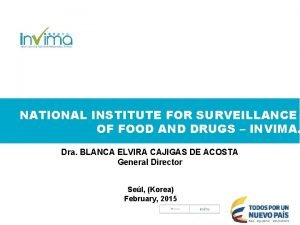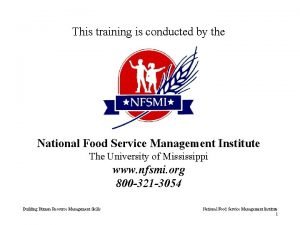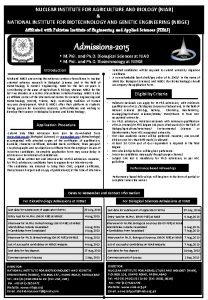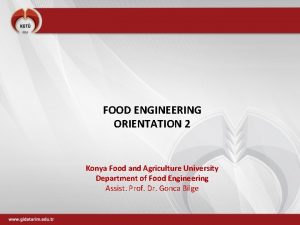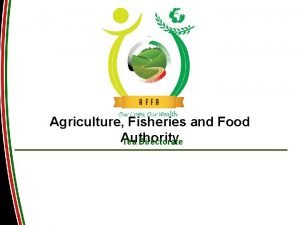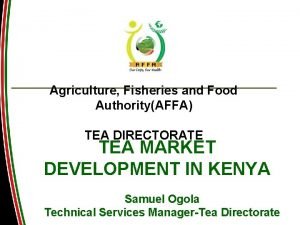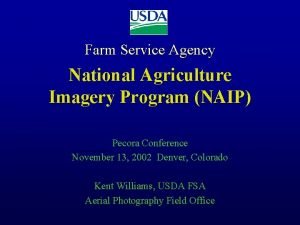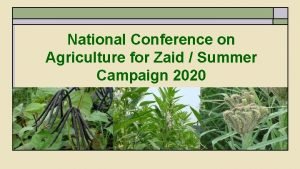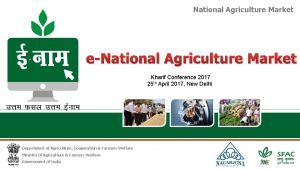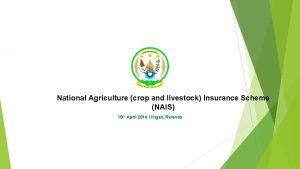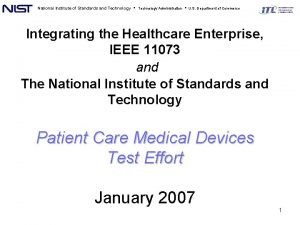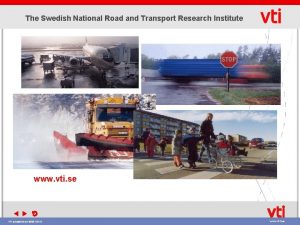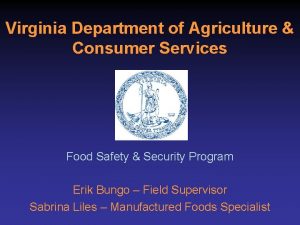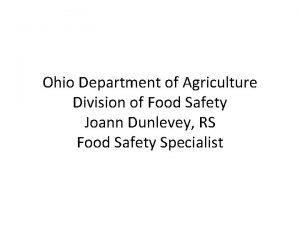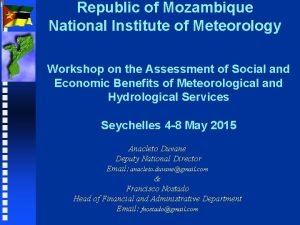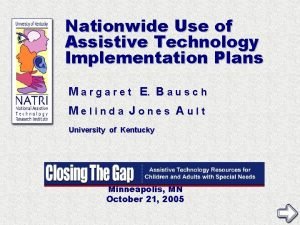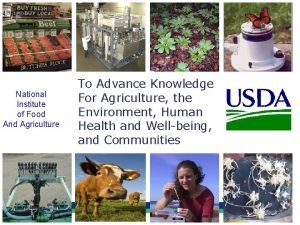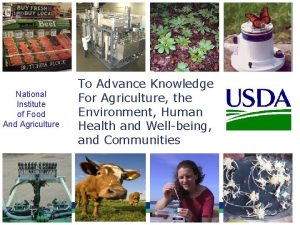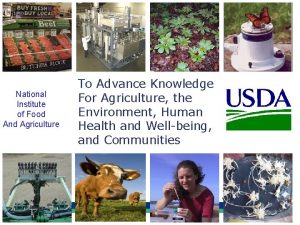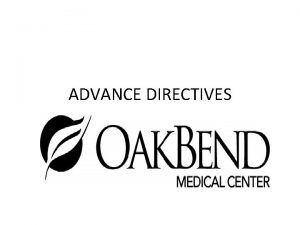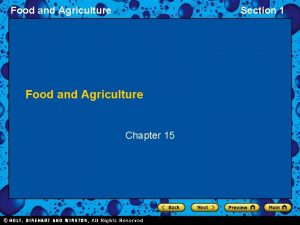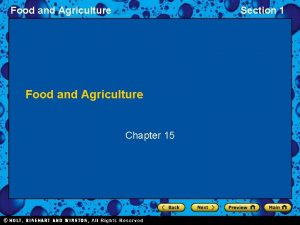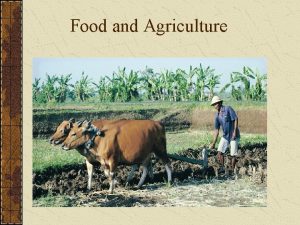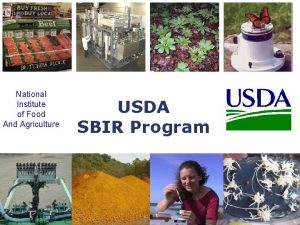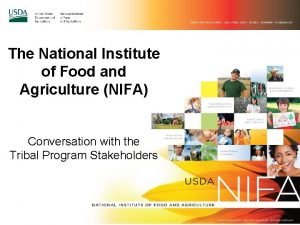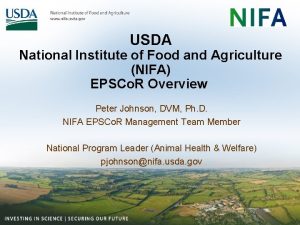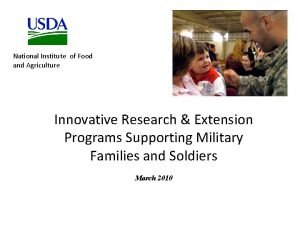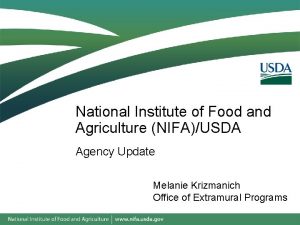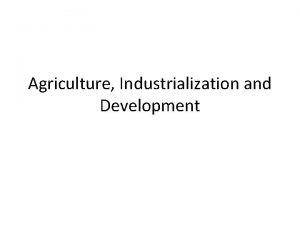National Institute of Food And Agriculture To Advance




















- Slides: 20

National Institute of Food And Agriculture To Advance Knowledge For Agriculture, the Environment, Human Health and Well-being, and Communities SBIR

Features of USDA SBIR Program • Award Grants Only - Ideas are Investigator-Initiated • Awards Based on Scientific and Technical Merit, PI and Company Qualifications, and Commercial Potential • Proposals Reviewed by Confidential Peer Review Using Outside Experts From Non-profit Organizations • Funds Allocated to Topic Areas in Proportion to Number of Proposals Received • Subcontracting to Universities and USDA Labs Permitted and Encouraged SBIR

Features of USDA SBIR Program • Phase I Grants = 8 Months/$100, 000 • Phase II Grants = 2 Years/$600, 000 • 12 Month No-cost Extension Available • Commercialization Assistance Programs for Both Phase I and Phase II Winners • Contact with SBIR Program Available Anytime SBIR

Topic Areas • Plant Production & Protection – Biology • Plant Production & Protection - Engineering • Animal Production & Protection • Aquaculture • Food Science & Nutrition • Biofuels and Biobased Products • Air, Water and Soils • Forests and Related Resources • Rural and Community Development • Small & Mid-Size Farms SBIR

Technology Areas Supported by the USDA/SBIR Program • • • Information Technology Robotics Electronics Biotechnology Nanotechnology Microelectro Mechanical Systems (MEMS) • Acoustics • Remote Sensing • • • Genetic Engineering Material/Coatings Food Safety Biofuels Machine Vision Precision Agriculture Engineering Physics Chemistry SBIR

History of USDA SBIR Funding SBIR

Geographical Distribution Of USDA SBIR Winners FY 83 - FY 15 SBIR

Application Submission • Application Submission Requires Many Steps to Complete the Process • Download the USDA SBIR Solicitation at https: //nifa. usda. gov/funding-opportunity/small-business-innovationresearch-program-phase-i • Electronic Submission is Mandatory via Grants. gov • Obtain Data Universal Number System (DUNS) Number • Register with System for Award Management (SAM) • Register your Business with Grants. gov • http: //www. grants. gov/web/applicants/organizationregistration. html • Register your company with the Small Business Administration (SBA) • https: //www. sbir. gov/registration SBIR

University and Government Scientist Involvement in USDA SBIR Program • Strongly encouraged • Scientists may serve as consultants or receive a subcontract (limited to no more than 1/3 of Phase I award or 1/2 of Phase II award) and continue to work full time at their home institution • Scientists may serve as the principal investigator on an SBIR grant, by reducing employment at their home institution to 49% for the duration of the grant and if the SBIR research is performed someplace other than their research lab • It is usually not acceptable for university or government scientists to serve as consultants and have all the research done in their lab SBIR

Advice for Phase I • Provide a VISION of where you want to be at the end of Phase II • Focus the Phase I research on critical enabling factor(s) • Sell the importance of your project • Provide a detailed experimental plan • Provide insight into commercial potential • Show connectivity with the communities you are intending to serve SBIR

Factors that Improve Chances for Commercial Success • • • High Scientific/Technical Merit Good Consultants, CRADA Business Expertise Phase III Partners Marketing Plan Participate in the Phase I and Phase II Commercialization Assistance Programs SBIR

Solicitation/Proposal Schedule: Phase I • FY 2018 Solicitation was Released on July 5, 2017 • Phase I Proposal Deadline will be October 5, 2017 • Panels will Meet in January & February of 2018 • Award Decisions will be Made in Early March 2018 • Phase I Grant Period will be from June 1, 2018 to January 31, 2019 Phase II • FY 2018 Solicitation will be released in late November of 2017 (only prior USDA Phase I winners are eligible) • Phase II Proposal Deadline Date will be March 8, 2018 • Phase II Grant Period will be from September 1, 2018 to August 31, 2020 SBIR

USDA SBIR HOMEPAGE www. nifa. usda. gov/fo/sbir • • • Program Information Solicitation (Request for Applications) Technical Abstracts Link to SBA and Other SBIR Programs Upcoming SBIR Conferences Find the Expert (CRIS & ARS) Power. Point Presentation Success Stories Impact Newsletter SBIR

U. S. Department of Agriculture Small Business Innovation Research Program Dr. Toby Ahrens Biofuels and Biobased Products Dr. Charles Cleland Forests and Related Resources Dr. Jodi Williams Food Science and Nutrition Dr. Gene Kim Aquaculture Dr. Robert Nowierski Plant Production and Protection – Biology Dr. Brent Elrod Rural and Community Development Dr. Denis Ebodaghe Small and Mid-Size Farms Scott Dockum Program Coordinator, SBIR Elden Hawkes Program Specialist, SBIR Dr. Robert Smith Animal Production and Protection Dr. Karelyn Cruz Air, Water and Soils Dr. Rachel Melnick Plant Production and Protection - Engineering SBIR

U. S. Department of Agriculture Small Business Innovation Research Program Charles Cleland Waterfront Centre 800 9 th Street, SW, Suite 3262 Washington, DC 20024 Phone: (202) 401 -6852 Fax: (202) 401 -6070 E-mail: ccleland@nifa. usda. gov Web Site: www. nifa. usda. gov/fo/sbir SBIR

Whole Trees, LLC Technology Developed • Structural Testing of Branched Timber and Truss Assemblies • Round timber can substitute for steel and concrete in medium and large scale construction under Type IV: "Heavy Timber Framing. " Commercialization Success • The company will provide the ceiling joists of the 57, 000 -square-foot Festival Foods grocery store which will include ash trees being removed from the city of Madison due to emerald ash borer infestation. • Raised $1. 6 M in private equity funding since the initial SBIR grant. SBIR History • Phase I – 2011 ($99 K) • Phase II – 2012 ($362 K) • 8. 1 Forests and Related Resources SBIR

Altaeros Energies Technology Developed • Altaeros Buoyant Airborne Turbine (BAT) leverages proven aerospace technology to lift a wind turbine into the strong, consistent winds beyond the reach of traditional towers. Commercialization Success • First commercial products to be sold in 2015. • Technology was featured in CNN’s 2014 edition of THE CNN 10: Inventions and in the New York Times. • Telecoms group Soft. Bank has invested $7 m in Altaeros Energies for future deployment of the BAT technology in Japan. SBIR History • Phase I – 2011 ($100 K) • Phase II – 2012 ($450 K) • 8. 6 Rural Development SBIR

Nitrate Elimination Company, Inc. Technology Developed • Developed nitrate test kits that allow farm managers to determine nitrate accumulation levels on the farm. • This test kit will help agricultural producers manage nitrate concentrations, reduce costly nitrogen fertilizer applications, and protect the environment from pollution. Commercialization Success • In the final stages to receive EPA certification as a standard method for all nitrate testing under the Clean Water Act. • Nitrate test kits are used as the standard method within all US Geological Survey (USGS) soil laboratories. SBIR History • Phase I – 2006 ($80 K) • Phase II – 2007 ($364 K) • 8. 4 Air, Water and Soils SBIR

Agra. Quest, Inc. Technology Developed • Fungicide called Serenade® • Non toxic to animals and to beneficial organisms. • Serenade® is approved for use in organic production. • Use of Serenade® helps manage development of resistance to synthetic fungicides. Commercialization Success • Serenade® has been sold in more than 23 countries • Sales of Serenade® have exceeded $23 million • Bayer AG's Crop. Science acquired Agra. Quest Inc. for close to $500 million in July of 2012 SBIR History • Phase I – 1997 ($65 K) • Phase II – 1998 ($250 K) • Company has had other Phase I and II projects with USDA SBIR • 8. 2 Plant Production and Protection - Biology SBIR

ANY QUESTIONS? SBIR
 Regulatory agencies
Regulatory agencies National food service management institute
National food service management institute Nuclear institute for agriculture and biology
Nuclear institute for agriculture and biology Konya food and agriculture university
Konya food and agriculture university Tea directorate
Tea directorate Ministry of food agriculture and fisheries denmark
Ministry of food agriculture and fisheries denmark 399
399 National agriculture imagery program
National agriculture imagery program National conference on agriculture for summer campaign
National conference on agriculture for summer campaign National mission for sustainable agriculture
National mission for sustainable agriculture National agriculture market
National agriculture market National agriculture insurance scheme
National agriculture insurance scheme Unit 2 food food food
Unit 2 food food food Food chain food chain food chain
Food chain food chain food chain Spike unist internship
Spike unist internship National institute of standards and technology
National institute of standards and technology Swedish national road and transport research institute
Swedish national road and transport research institute Virginia department of agriculture and consumer services
Virginia department of agriculture and consumer services Ohio department of agriculture food safety
Ohio department of agriculture food safety National institute of meteorology
National institute of meteorology Assistive technology implementation plan sample
Assistive technology implementation plan sample
